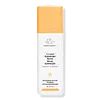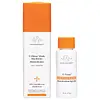What's inside
What's inside
 Key Ingredients
Key Ingredients

 Benefits
Benefits

 Concerns
Concerns

No concerns
 Ingredients Side-by-side
Ingredients Side-by-side

Water
Skin ConditioningPropanediol
SolventSodium Ascorbyl Phosphate
AntioxidantGlycerin
HumectantIsodecyl Neopentanoate
EmollientSqualane
EmollientNeopentyl Glycol Diheptanoate
EmollientC9-12 Alkane
SolventSodium Polyacryloyldimethyl Taurate
Emulsion StabilisingAscorbyl Glucoside
AntioxidantCoco-Caprylate/Caprate
EmollientSclerocarya Birrea Seed Oil
HumectantPullulan
Sclerotium Gum
Emulsion StabilisingDiglucosyl Gallic Acid
Sorbitan Sesquiisostearate
EmulsifyingGlutathione
Sodium Hyaluronate
HumectantSorbeth-30 Tetraisostearate
EmulsifyingDipropylene Glycol
HumectantPhloretin
AntioxidantSodium Citrate
BufferingSodium Metabisulfite
AntioxidantPPG-8-Ceteth-20
EmulsifyingGluconolactone
Skin ConditioningAcrylates/Beheneth-25 Methacrylate Copolymer
Citric Acid
BufferingTetrasodium Glutamate Diacetate
Silica
AbrasiveLecithin
EmollientXanthan Gum
EmulsifyingTocopheryl Acetate
AntioxidantSodium Hydroxide
BufferingPhenoxyethanol
PreservativeSodium Benzoate
MaskingChondrus Crispus Extract
Skin ConditioningWater, Propanediol, Sodium Ascorbyl Phosphate, Glycerin, Isodecyl Neopentanoate, Squalane, Neopentyl Glycol Diheptanoate, C9-12 Alkane, Sodium Polyacryloyldimethyl Taurate, Ascorbyl Glucoside, Coco-Caprylate/Caprate, Sclerocarya Birrea Seed Oil, Pullulan, Sclerotium Gum, Diglucosyl Gallic Acid, Sorbitan Sesquiisostearate, Glutathione, Sodium Hyaluronate, Sorbeth-30 Tetraisostearate, Dipropylene Glycol, Phloretin, Sodium Citrate, Sodium Metabisulfite, PPG-8-Ceteth-20, Gluconolactone, Acrylates/Beheneth-25 Methacrylate Copolymer, Citric Acid, Tetrasodium Glutamate Diacetate, Silica, Lecithin, Xanthan Gum, Tocopheryl Acetate, Sodium Hydroxide, Phenoxyethanol, Sodium Benzoate, Chondrus Crispus Extract
Water
Skin ConditioningDimethyl Isosorbide
SolventAscorbic Acid
AntioxidantLaureth-23
CleansingGlycerin
HumectantTocopherol
AntioxidantLactobacillus/Pumpkin Ferment Extract
Skin ConditioningSclerocarya Birrea Seed Oil
HumectantDipotassium Glycyrrhizate
HumectantGlycyrrhiza Glabra Root Extract
BleachingVitis Vinifera Juice Extract
AntioxidantFerulic Acid
AntimicrobialPhyllanthus Emblica Fruit Extract
HumectantCamellia Sinensis Leaf Extract
AntimicrobialLactobacillus/Punica Granatum Fruit Ferment Extract
Skin ConditioningPropanediol
SolventGluconolactone
Skin ConditioningSodium Hyaluronate Crosspolymer
HumectantSodium Hyaluronate
HumectantOryza Sativa Bran Extract
Skin ConditioningGlutamylamidoethyl Imidazole
Tetrahydrobisdemethoxydiferuloylmethane
AntioxidantTetrahydrodemethoxydiferuloylmethane
AntioxidantTetrahydrodiferuloylmethane
AntioxidantPentylene Glycol
Skin ConditioningCaprylhydroxamic Acid
Leuconostoc/Radish Root Ferment Filtrate
AntimicrobialSorbic Acid
PreservativePhenoxyethanol
PreservativeSodium Benzoate
MaskingCaprylyl Glycol
EmollientChondrus Crispus Extract
Skin ConditioningEthylhexylglycerin
Skin ConditioningWater, Dimethyl Isosorbide, Ascorbic Acid, Laureth-23, Glycerin, Tocopherol, Lactobacillus/Pumpkin Ferment Extract, Sclerocarya Birrea Seed Oil, Dipotassium Glycyrrhizate, Glycyrrhiza Glabra Root Extract, Vitis Vinifera Juice Extract, Ferulic Acid, Phyllanthus Emblica Fruit Extract, Camellia Sinensis Leaf Extract, Lactobacillus/Punica Granatum Fruit Ferment Extract, Propanediol, Gluconolactone, Sodium Hyaluronate Crosspolymer, Sodium Hyaluronate, Oryza Sativa Bran Extract, Glutamylamidoethyl Imidazole, Tetrahydrobisdemethoxydiferuloylmethane, Tetrahydrodemethoxydiferuloylmethane, Tetrahydrodiferuloylmethane, Pentylene Glycol, Caprylhydroxamic Acid, Leuconostoc/Radish Root Ferment Filtrate, Sorbic Acid, Phenoxyethanol, Sodium Benzoate, Caprylyl Glycol, Chondrus Crispus Extract, Ethylhexylglycerin
 Reviews
Reviews

Ingredients Explained
These ingredients are found in both products.
Ingredients higher up in an ingredient list are typically present in a larger amount.
Chondrus Crispus Extract comes from a red algae native to the northern Atlantic coasts of Europe and North America. It helps hydrate the skin and is rich in antioxidants.
The antioxidants in chondrus crispus include lutein and zeaxanthin. Lutein has the ability to filter blue light from screens.
Other contents of chondrus crispus include polysaccharides, peptides, and amino acids. These help hydrate the skin.
What's the difference between algae and seaweed?
Algae is a broad term that includes seaweed. Not all algae is seaweed.
Gluconolactone is a PHA. PHAs are a great gentle alternative to traditional AHAs.
When applied, Gluconolactone has the same affect on skin as AHAs such as lactic acid. It helps dissolve the dead skin cells in the top layer of your skin. This improves texture and brightens the skin.
PHAs are more gentle than AHAs due to their larger structure. They do not penetrate as deeply as AHAs and take a longer time to dissolve dead cells. Studies show PHAs do not cause as much irritation.
Gluconolactone has some interesting properties:
In a 2004 study, Gluconolactone was found to prevent UV damage in mouse skin cells and has not been found to increase sun sensitivity. However, we still recommend wearing SPF daily.
This ingredient is is an created by reacting gluconic acid with an alcohol.
Learn more about GluconolactoneGlycerin is already naturally found in your skin. It helps moisturize and protect your skin.
A study from 2016 found glycerin to be more effective as a humectant than AHAs and hyaluronic acid.
As a humectant, it helps the skin stay hydrated by pulling moisture to your skin. The low molecular weight of glycerin allows it to pull moisture into the deeper layers of your skin.
Hydrated skin improves your skin barrier; Your skin barrier helps protect against irritants and bacteria.
Glycerin has also been found to have antimicrobial and antiviral properties. Due to these properties, glycerin is often used in wound and burn treatments.
In cosmetics, glycerin is usually derived from plants such as soybean or palm. However, it can also be sourced from animals, such as tallow or animal fat.
This ingredient is organic, colorless, odorless, and non-toxic.
Glycerin is the name for this ingredient in American English. British English uses Glycerol/Glycerine.
Learn more about GlycerinPhenoxyethanol is a preservative that has germicide, antimicrobial, and aromatic properties. Studies show that phenoxyethanol can prevent microbial growth. By itself, it has a scent that is similar to that of a rose.
It's often used in formulations along with Caprylyl Glycol to preserve the shelf life of products.
Propanediol is an all-star ingredient. It softens, hydrates, and smooths the skin.
It’s often used to:
Propanediol is not likely to cause sensitivity and considered safe to use. It is derived from corn or petroleum with a clear color and no scent.
Learn more about PropanediolSclerocarya Birrea Seed Oil is the oil expressed from the seeds of the Marula plant. In South Africa, Marula is called "an elephant's favorite treat".
Marula seed oil is a non-fragrant oil. It is rich in fatty acids, such as oleic, linoleic, palmitic, stearic, and more. These fatty acids help hydrate the skin.
Other components of marula seed oil include vitamin E and antioxidants such as flavonoids.
Due to the fatty acid content, this ingredient may not be fungal-acne safe.
Learn more about Sclerocarya Birrea Seed OilSodium Benzoate is a preservative. It's used in both cosmetic and food products to inhibit the growth of mold and bacteria. It is typically produced synthetically.
Both the US FDA and EU Health Committee have approved the use of sodium benzoate. In the US, levels of 0.1% (of the total product) are allowed.
Sodium benzoate works as a preservative by inhibiting the growth of bacteria inside of cells. It prevents the cell from fermenting a type of sugar using an enzyme called phosphofructokinase.
It is the salt of benzoic acid. Foods containing sodium benzoate include soda, salad dressings, condiments, fruit juices, wines, and snack foods.
Studies for using ascorbic acid and sodium benzoate in cosmetics are lacking, especially in skincare routines with multiple steps.
We always recommend speaking with a professional, such as a dermatologist, if you have any concerns.
Learn more about Sodium BenzoateSodium Hyaluronate is hyaluronic acid's salt form. It is commonly derived from the sodium salt of hyaluronic acid.
Like hyaluronic acid, it is great at holding water and acts as a humectant. This makes it a great skin hydrating ingredient.
Sodium Hyaluronate is naturally occurring in our bodies and is mostly found in eye fluid and joints.
These are some other common types of Hyaluronic Acid:
Learn more about Sodium HyaluronateWater. It's the most common cosmetic ingredient of all. You'll usually see it at the top of ingredient lists, meaning that it makes up the largest part of the product.
So why is it so popular? Water most often acts as a solvent - this means that it helps dissolve other ingredients into the formulation.
You'll also recognize water as that liquid we all need to stay alive. If you see this, drink a glass of water. Stay hydrated!
Learn more about Water